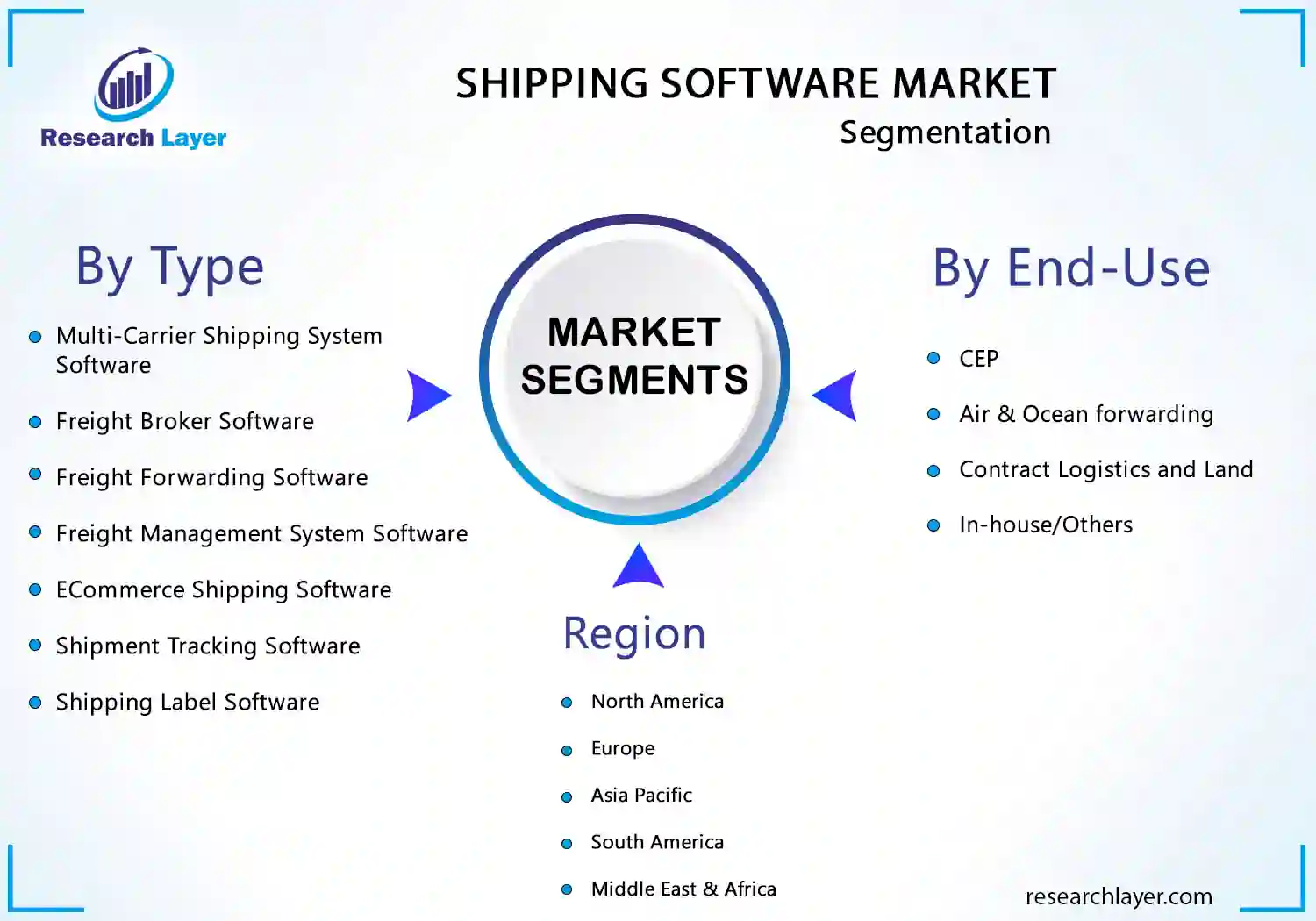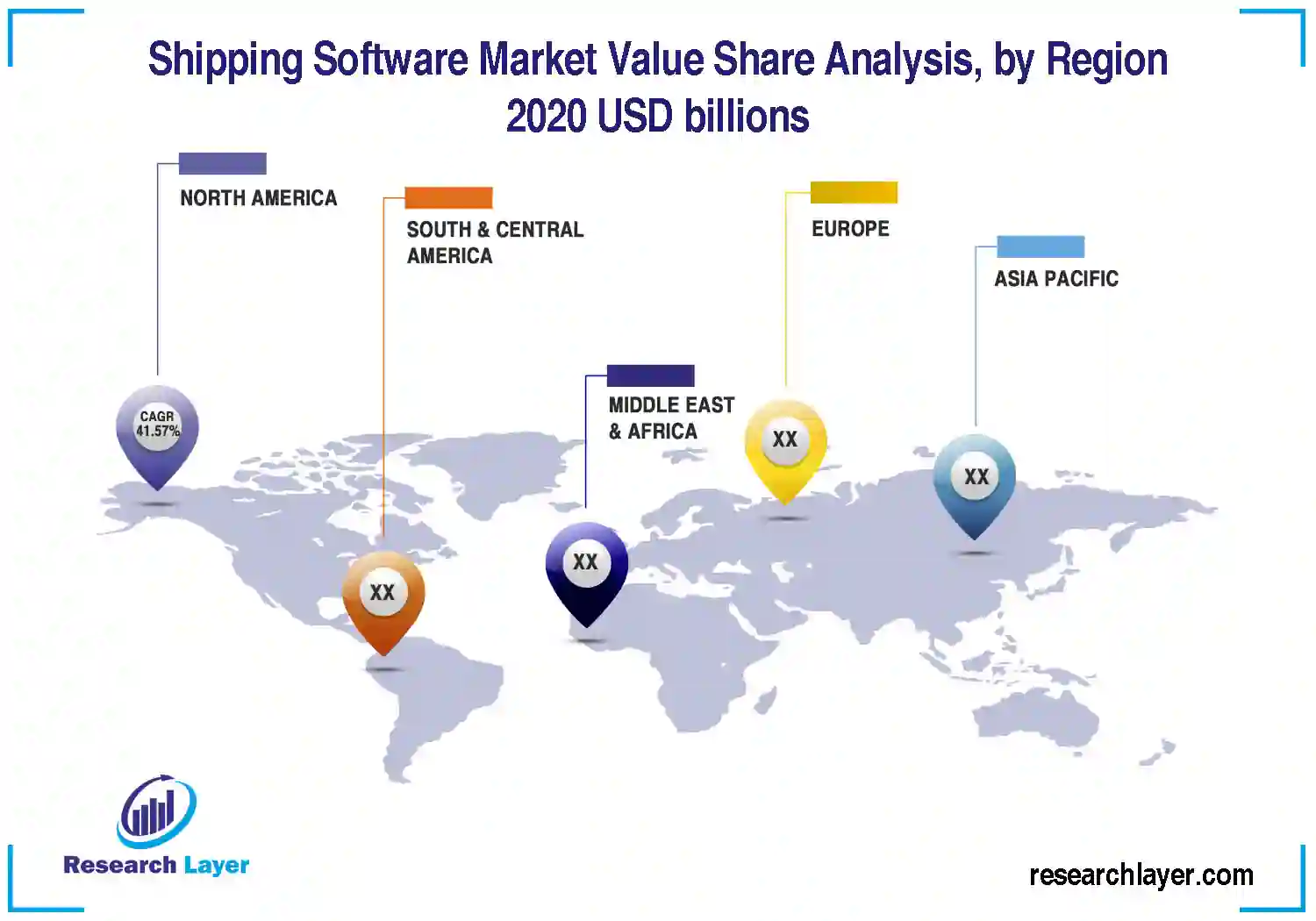 +1 915 229 3004 (U.S.) |
+1 915 229 3004 (U.S.) |  +44 7452 242832 (U.K.)
+44 7452 242832 (U.K.)
 +1 915 229 3004 (U.S.) |
+1 915 229 3004 (U.S.) |  +44 7452 242832 (U.K.)
+44 7452 242832 (U.K.)

The shipping software market over the globe was valued at a market value of USD 1,623.8 million in 2020 and is expected to account 3,007.8 million in 2027, growing with a CAGR of 8.95% during the forecast period.
The shipping software is an integrated platform that helps and aids organizations in the process of shipment tracking, coordinating, planning, and routing on a real-time basis. Traditionally, supply chain management in the ships was managed through manual data entry procedures and phone calls, resulting in huge amounts of paper data and inefficiency. Hence, the adoption of shipping software replacing the traditional method of shipping management is a lucrative solution for market growth. Major companies in the shipping sector are adopting shipping software which is acting as the primary factor driving the market growth. Furthermore, there are various other advantages of shipping software, such as this software being helpful for both the customer and the business. It allows for faster shipping time, and also this leads to customer satisfaction. Other benefits of shipping software are user-friendly and include the ability to manage all shipping centers via one portal, sort, and edit orders, and check imported orders.


Download Free Report Sample to learn more about this report.
The coronavirus (COVID-19) outbreak, which began in Wuhan, China, has rapidly spread all over the world, infecting millions of people and resulting in a high mortality rate. According to WHO, in March 2020, the governments are implementing several restrictions such as school closures, travel bans, and curfews, and the lives of billions are affected. The shipping industry itself is facing pressure to innovate to make shipping operations more efficient, greener, and cheaper, and the industry is still battling the unprecedented challenges resulting from the COVID-19 outbreak. According to the European Maritime Safety Agency, the impact of the COVID-19 pandemic on certain shipping activities. According to EMSA, shipping routes from Europe to China and from Europe to the US have been affected, which in turn affected the overall market growth of the shipping software market. For instance, in January 2019, there were approximately 53,035 ship calls at EU ports, and around 49,908 ship calls in January 2021 were recorded. The number of shipping calls decreased by 6% in comparison with 2019.
Due to the COVID-19 pandemic, the market for shipping software has observed a decline in the pandemic owing to factors such as a dip in export activity globally. For instance, India’s export activity recorded a 34.57% decline in the shipment of products, such as leather, gems, and jewelry, etc., in March 2020.
Furthermore, looking at the positive impact of the market growth of the shipping software market, the COVID19 outbreak compelled shipping industry owners to adopt online sales which led to an increase in the demand for shipping software. This factor intur is fueling the demand for shipping software market. Demand for geo-locating orders, scheduling deliveries, and providing visual access to delivery teams bolstered the growth of the shipping software market. In addition, the rising trend of real-time tracking is gaining traction for market growth in order to resolve critical courier delays and avoid quality issues faced by delivery companies. Such factors are considered a driving factor for market growth. However, some challenges are posed to the shipping software market; international shipping lacks unified region-based platforms or software that can visualize all delivery pipelines and adhere to local legal standards, which is acting as a challenging factor in the COVID-19 pandemic. Such factors are showcasing a moderate impact on the market growth of the shipping software market.
E-commerce is known as the buying and selling of goods or services through the help of the internet. It also makes it easy to transfer money and data to complete the sales. This e-commerce platform is widely known as electronic commerce or internet commerce. Small businesses, independent freelancers, and large corporations have all benefited from the eCommerce platform worldwide. There are various types of E-commerce platforms such as Business to Consumer (B2C), Business to Business (B2B), Consumer to Consumer (C2C), and Consumer to Business (C2B). Moreover, some of the applications include retail, wholesale, drop shipping, crowdfunding, subscription, physical products, digital products, and other services. Shipping software is widely used in E-commerce platforms to save time and money. It allows you to manage, import, and ship your online orders. It provides automated solutions in an eCommerce business.
In recent years, there has been a high demand for e-commerce platforms across the world. For instance, according to IBEF (India Brand Equity Foundation), in India E-commerce has changed the way of business. The Indian E-commerce industry is anticipated to grow to USD 200 billion by 2026 from USD 38.5 billion as of 2017. This e-commerce platform growth is enhanced by an increase in internet and smartphone penetration. In addition, on 30th July 2019, according to International Trade Administration (ITA), China became the world’s largest eCommerce market, with more than 50% of global eCommerce transactions coming from China. In 2018, it was found that China’s online retail transactions reached more than $1.33 trillion and were expected to reach $1.99 trillion by the end of 2019. In 2018, the number of digital buyers in China exceeded 560 million, with the total number predicted to reach 634 million in 2020.
Hence, the increasing demand for an e-commerce platform in India, China, and other countries has boosted the growth of the shipping software market.
Surge in Export and Import Activities Globally
Exporting is the act of supplying goods or services from one country to another. Imports are the goods and services that are purchased from other countries rather than purchasing domestically produced items.
There is high demand for export and import activities worldwide, which allows for the development of the national financial system and expands global markets. Imports and export play an important role in boosting the GDP and wealth growth of any country. Shipping software is used in import and export activities to store customer and product information in a database. It can be used before beginning export and import activities from one country to another. With the increase in usage of shipping software, export and import agents can collect, create, and deliver accurate trade documents worldwide for every international trade transaction. This shipping software also assists agents in enhancing their efficiency in completing import and export transactions by minimizing errors.
According to U.S. Census Bureau, on September 3, 2020, the nation’s international related-party trade accounted for around 43.2 percent ($1,790.0 billion) of total goods trade ($4,145.0 billion). Related party total goods trade is based on imports for consumption and total exports. (September 3, 2020). In addition, as per data obtained from The World Bank Group, in 2019, Germany imported around $1.6t and exported around $1.8t, resulting in more than $223.8 billion in a positive balance of payments. In 2015, Capital Goods was the biggest export area for Germany, with 37.80% of total exports. Hence, increasing usage of shipping software has increased the business across the globe through export & import activities.
Stringent rules and regulation
Stringent rules, laws, or conditions are apparent or strictly controlled. Stringent security measures have been introduced at all ports around the world. Accordingly, the ongoing production and contraction due to the spread of Covid-19 have a major effect on the shipping market. During the Covid-19 pandemic time, the economic downturn decreased production and trade activities which has slowed down the market. In addition, most government all over the world has banned(regulated) shipping, import-export, and port traffic. Due to this pandemic, the shipping and logistic market has directly affected the world economy, shipping, and port traffic volume. Multiple nations have announced extensions of lockdowns, with strict restrictions on the movement of ships which has impacted the shipping software market
Growing demand from emerging market
An emerging market is defined as the market that is transitioning from the “developing” phase to the “developed” phase. India, Mexico, Russia, Pakistan, Saudi Arabia, China, and Brazil are examples of emerging market economies. In emerging-market, the government often implements policies that promote industrialization as well as rapid economic expansion. There is a rising demand for Retail & eCommerce, 3PL/Contract Logistics, Courier & Postal Services, and Freight/Cargo Forwarding in emerging markets. Recent developments in the US-China trade war discussions have resulted in a rise in foreign investment, infrastructure development, as wellas merger and acquisition (M&A) activity in other developing economies, which has fuelled the demand for shipping software. For instance, the statistics published by Global Times in 2015, China overtaken the U.S market to become the world's top nation in terms of express delivery volumes in 2014, China's State Post Bureau (SPU). In addition, it is also found that the total express delivery volume reached around 13.96 billion items last year, surging 51.9 percent from a year earlier. Hence, increasing demand from emerging markets will create an opportunity for the shipping software market in the future.
The worldwide shipping software market is divided into five main regions such as North America, Europe, Asia-Pacific, Middle East & Africa, and South America. North America dominated the shipping software market owing to various factors such as growing acceptance of shipping software in the shipping industry, explosive growth in E-commerce, presence of major market players in the shipping software, robust transport management system in this system, government regulations in favor of shipping and advantages offered by the companies of shipping software is propelling the market growth. For instance, the software developers in the shipping software market are adopting easy-to-use logistics platforms, which is resulting in a seamless and integrated shipping workflow. Such elements are anticipated to propel the market growth of shipping software.


Download Free Report Sample to learn more about this report.
An emerging market s defined as the market that is transitioning from the “developing” phase to the “developed” phase. India, Mexico, Russia, Pakistan, Saudi Arabia, China, and Brazil are examples of emerging market economies. In emerging-market, the government often implements policies that promote industrialization as well as rapid economic expansion.
There is a rising demand for Retail & eCommerce, 3PL/Contract Logistics, Courier & Postal Services, and Freight/Cargo Forwarding in emerging markets. Recent developments in the US-China trade war discussions have resulted in a rise in foreign investment, infrastructure development, as well as merger and acquisition (M&A) activity in other developing economies, which has fuelled the demand for shipping software. For instance, the statistics published by Global Times in 2015, China, overtaken the U.S market to become the world's top nation in terms of express delivery volumes in 2014, China's State Post Bureau (SPU). In addition, it is also found that the total express delivery volume reached around 13.96 billion \items last year, surging 51.9 percent from a year earlier. Hence, increasing demand from emerging markets will create an opportunity for the shipping software market in the future.
The global shipping software market is divided into five main regions such as North America, Europe, Asia-Pacific, Middle East & Africa, and South America. North America dominated the shipping software market owing to various factors such as growing acceptance of shipping software in the shipping industry, explosive growth in E-commerce, presence of major market players in the shipping software, robust transport management system in this system, government regulations in favor of shipping and advantages offered by the companies of shipping software is propelling the market growth. For instance, the software developers in the shipping software market are adopting easy to use logistics platforms, which is resulting in a seamless and integrated shipping workflow. Such elements are anticipated to propel the market growth of shipping software.
Based on the product type, the shipping software market is primarily split into multi-carrier shipping system software, freight broker software, freight forwarding software, freight management system software, ecommerce shipping software, shipment tracking software, shipping label software. Among these multi-carrier shipping system software is dominating with market revenue of 1074.6 USD Million in 2027 and it growing at a CAGR of 9.47% during the forecast period.
Based on the shipping software end use, the shipping software market is segmented into CEP, Air & Ocean forwarding, Contract Logistics and Land, In-house/Others. Among these Land, In-house/Others is dominating with market revenue of 1248.3 USD Million in 2027 and it growing at a CAGR of 8.91% during the forecast period.
The market is analyzed across five geographical regions, namely, North America (U.S., Canada and Mexico), Latin America (Brazil, Argentina, Columbia, South Africa, Chile, Others), Europe (UK, Germany, France, Spain, Russia and others), Asia-Pacific (China, Japan, India, Australia, Singapore, South East Asia and Others), and Middle East & Africa (Saudi Arabia, UAE, Egypt, South Africa, Nigeria and Others).


Download Free Report Sample to learn more about this report.
The key players in the industry include 2Ship Solutions, Stamps.com, WiseTech Global, Epicor Software Corporation, Shippo, Endcia, Metapack, Pierbridge, Logistyx Technologies, ShipHawk, Pitney Bowes, Shipwire, V-Technologies, ProShip, ReadyCloud, LLC., Temando, Teapplix, Malvern Systems.
In September, 2020, Logistyx Technologies, one of the leaders in transportation management for parcel shipping, continued partnership with Manhattan Associates, a technology leader in supply chain and omnichannel commerce, as the company releases the latest enhancements to shift its product to the cloud.
In June, 2021, Pitney Bowes Inc. expanded its lockers portfolio with the launch of ParcelPoint Smart Lockers, a new suite of robust, secure contactless locker solutions unique to Pitney Bowes.
This report anticipates revenue growth at regional & country levels and provides an analysis based on the industry trends in each and every sub-segments from 2017 to 2027. For the purpose of this study, Research Layer has segmented the global shipping software market based on product type, end use, and region:
Report Scope
The global Shipping Software market size was estimated at USD 1,623.8 Million in 2022 and is expected to reach USD 3,007.8 Million in 2028.
The market is expected to grow CAGR of 8.95% during forecast period 2022-2028
E-commerce is the major driving factor for the Shipping Software Market
Leading market players of Shipping Software Market are 2Ship Solutions, Stamps.com, WiseTech Global, Epicor Software Corporation, Shippo, Endcia, Metapack, Pierbridge, Logistyx Technologies, ShipHawk, Pitney Bowes, Shipwire, V-Technologies, ProShip, ReadyCloud, LLC., Temando, Teapplix, Malvern Systems
Asia Pacific holds the highest market share in regional segment.


Report Code :
RL6510
Published on :
Upcoming
Request a Free Sample Report